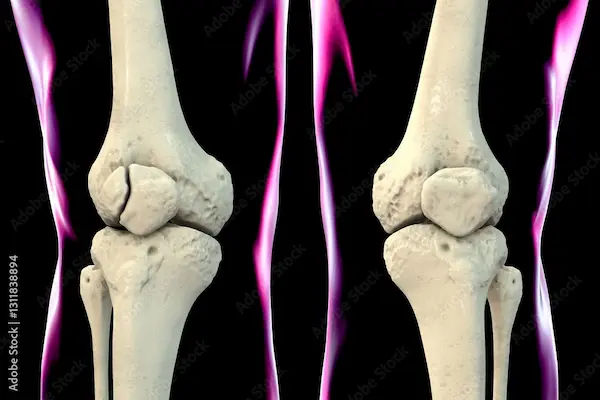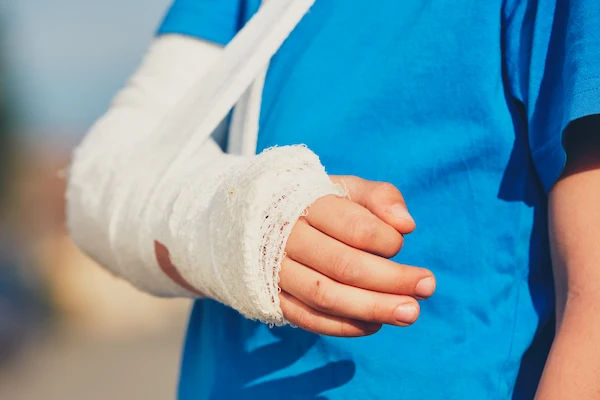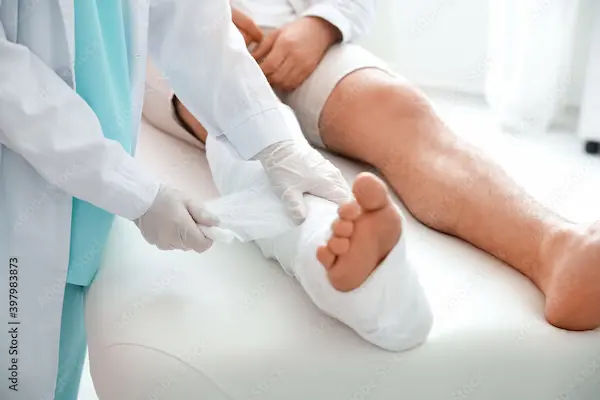What Leads To Signs Of Bone Fracture Types
Discover the causes and recognize the key signs of different bone fracture types, including stress, compound, and hairline breaks. Learn when to seek urgent medical care.

Written by Dr. Mohammed Kamran
Reviewed by Dr. Rohinipriyanka Pondugula MBBS
Last updated on 27th Oct, 2025
.webp?tr=q-80,f-webp,w-350,dpr-2,c-at_max 700w)
Introduction
If you’ve had a painful fall, heard a snap, or noticed swelling that won’t quit, you might be wondering if it’s a bone fracture. From a hairline crack to a complex break, fractures vary widely, but the earlier you recognize the signs and get the right care, the better your recovery. In this guide, we unpack what leads to bone fractures, how to spot the signs, and the types you’ll most often hear about in the clinic. You’ll learn how doctors confirm a fracture, what treatment typically involves (from splints and casts to surgery), how healing progresses, and what you can do to prevent the next injury. Whether you’re a parent, athlete, older adult, or simply someone who wants to be prepared, this comprehensive, plain-language resource draws on leading medical sources to help you make confident decisions. If symptoms persist beyond two weeks, consult a doctor online with Apollo 24|7 for further evaluation. For suspected severe injuries or open wounds, seek emergency care immediately. Let’s start with what a bone fracture actually is—and what it isn’t.
What Is a Bone Fracture?
A bone fracture is a partial or complete break in a bone, caused when stress on the bone exceeds its strength. While many people use “broken bone” and “fracture” differently, clinicians consider them the same. Fractures can be simple cracks (hairline or stress fractures) or complex breaks with multiple fragments.
Bone fracture vs sprain vs contusion
- Sprain: Injury to ligaments around a joint. Expect pain, swelling, and limited motion but usually no bone deformity. X-rays are often normal.
- Strain: Injury to muscle or tendon. Pain with specific movements, less swelling than sprains.
- Contusion (bruise): Blunt-force injury to soft tissue; skin discoloration and tenderness but bones are intact.
- Fracture: Pain with weight-bearing or movement of the affected area, swelling, sometimes deformity or abnormal motion; X-ray often shows a clear break, though stress fractures may not be visible early.
Who is most at risk?
- Children and teens: Growth plate (physis) fractures, greenstick, and buckle (torus) fractures are common due to growing bones.
- Adults: Work or sports injuries; wrist, ankle, and clavicle fractures are frequent.
- Older adults: Hip, spine compression, and wrist fractures often follow low-energy falls, frequently related to osteoporosis.
- People with bone-weakening conditions: Osteoporosis, chronic steroid use, some cancers, and endocrine disorders increase risk of pathologic or insufficiency fractures.
Consult a Top General Physician
What Leads to Bone Fractures? Causes and Risk Factors
While a hard fall or collision can break a healthy bone, many fractures occur because bone strength is reduced or repetitive stress accumulates.
Traumatic causes (falls, sports, road accidents)
- Falls are the leading cause of fracture in older adults; hip, wrist, and shoulder are common sites.
- Sports injuries often involve the ankle, hand, clavicle, and forearm from twisting, direct blows, or high-impact landings.
- Road traffic accidents can cause high-energy fractures with multiple fragments and soft-tissue injury.
Insufficiency and pathologic fractures (osteoporosis, cancer)
- Osteoporosis reduces bone density and strength. Globally, one in three women and one in five men over 50 will suffer an osteoporotic fracture in their lifetime.
- Pathologic fractures occur through bone weakened by disease (e.g., metastatic cancer to bone, multiple myeloma, bone cysts).
- Compression fractures of the spine are often insufficiency fractures from low-energy forces in osteoporotic bone.
Modifiable risks (vitamin D deficiency, smoking, diabetes)
- Low vitamin D and calcium intake impair bone mineralization and healing.
- Smoking and excessive alcohol use decrease bone density and delay healing.
- Poorly controlled diabetes is associated with impaired bone quality and a higher risk of complications, including infection and delayed union.
- Certain medications (chronic corticosteroids, some anticonvulsants) weaken bone; review your meds with a clinician if you have recurrent fractures.
Unique insight: Think “bone strength = material + design + load.” Genetics and nutrition set material quality; architecture (bone geometry) adapts with training and age; loads (falls, jumps, twist) determine if forces exceed safety margins. Adjust any one—stronger bone, safer environment, smarter movement—and risk falls.
Signs and Symptoms You Shouldn’t Ignore
Classic signs of a broken bone
- Immediate, localized pain that worsens with movement or weight-bearing
- Swelling and bruising developing over minutes to hours
- Deformity, shortened limb, or joint at an odd angle
- Inability to use the limb or bear weight
- Crepitus (grating) with motion
- Open wound with exposed bone (open/compound fracture)
Subtle signs of stress fractures
- Gradual onset of pinpoint pain that escalates with activity and eases at rest
- Minimal swelling; often normal X-ray in the first 1–2 weeks
- Common sites: foot (metatarsals), shin (tibia), hip (femoral neck), and pelvis in runners and military recruits
If you’re debating “hairline fracture vs sprain,” note that stress fractures typically worsen with repetitive loading (e.g., each run), while sprains hurt with specific joint movements.
Emergency red flags (seek urgent care)
- Open wound or visible bone
- Numbness, tingling, pale/cool limb suggesting nerve or vessel injury
- Severe pain unrelieved by rest or medication; pain with increasing pressure in the limb (possible compartment syndrome)
- Suspected hip fracture, femoral shaft injury, or spinal injury
- Head injury, loss of consciousness, or multiple injuries with the fall
If you’re unsure whether symptoms point to a bone fracture and pain or swelling persists beyond two weeks, consult a doctor online with Apollo 24|7 for timely evaluation.
Types of Bone Fractures Explained
Closed vs open (compound)
- Closed: Skin intact.
- Open: Bone pierces skin or wound communicates with the fracture. Higher infection risk; needs urgent antibiotics, tetanus update, and surgical cleaning.
Displaced vs non-displaced; stable vs unstable
- Displaced: Ends no longer aligned; often needs reduction and possibly surgery.
- Non-displaced: Fragments remain aligned; usually managed with immobilization.
- Stability depends on fracture pattern, location, and soft-tissue integrity.
Pattern-based types you’ll hear in clinic
- Transverse: Horizontal break across the bone
- Oblique: Angled break
- Spiral: Twisting injury, often in sports
- Comminuted: Bone broken into three or more pieces
- Impacted: Ends driven into each other (common around the wrist and hip)
- Intra-articular: Involves the joint surface; higher risk of arthritis if not aligned
Compression and special cases
- Compression fractures: Common in the spine, especially with osteoporosis, causing sudden back pain and height loss.
- Stress (hairline) fractures: From repetitive microtrauma; frequent in runners, dancers, and military recruits.
Pediatric fracture patterns
- Greenstick: Bone bends and cracks on one side, typical in children
- Buckle (torus): Compression causes the bone to “buckle”
- Growth plate (Salter-Harris): Injuries to the physis; require careful alignment to prevent growth disturbances
Unique insight: Your X-ray label is a roadmap. An “intra-articular, displaced, comminuted distal radius fracture” says: near the wrist (distal), enters the joint (intra-articular), misaligned (displaced), multi-piece (comminuted). Each descriptor influences treatment and rehab.
How Fractures Are Diagnosed?
Clinical examination and special tests
- Clinicians assess deformity, swelling, tenderness, and range of motion.
- Functional tests (e.g., inability to bear weight after an ankle twist) raise suspicion for fracture.
- Neurovascular check: pulses, capillary refill, sensation, and motor function to detect nerve or vessel injury.
Imaging: X-ray, CT, MRI, ultrasound, bone scan
- X-ray: First-line and widely available; shows most fractures and alignment.
- CT: Best for complex or intra-articular fractures needing surgical planning.
- MRI: Highly sensitive for stress fractures and occult fractures not visible on X-ray; also shows soft tissues.
- Ultrasound: Can detect some fractures in children and ribs; operator-dependent.
- Bone scan: Sensitive for stress fractures when MRI is not available.
Labs and bone density (DEXA) when indicated
- Vitamin D, calcium, phosphate, parathyroid hormone may be checked in recurrent or insufficiency fractures.
- DEXA scan assesses bone mineral density to quantify osteoporosis risk.
Apollo 24|7 offers convenient home collections for labs like vitamin D, calcium, and HbA1c, which can reveal correctable risks that affect bone strength and healing.
First Aid and Immediate Care
Immobilization, ice, elevation, pain control
- Immobilize the area with a splint using a rigid object (board, rolled magazine) and secure above and below the suspected fracture.
- Apply ice wrapped in cloth for 15–20 minutes at a time; elevate above heart level to reduce swelling.
- Use over-the-counter pain relief if appropriate (paracetamol/acetaminophen; ibuprofen if no contraindications).
What not to do?
- Don’t try to “push the bone back in” or force a limb straight.
- Don’t apply heat or massage in the first 48 hours.
- Don’t remove protruding objects; stabilize in place until medical help arrives.
- Don’t eat or drink if surgery might be needed soon.
When to self-care, call a doctor, or go to the ER?
- ER now: Open fractures, severe deformity, loss of pulse/sensation, suspected hip or spine fracture, head injury, or multiple injuries.
- Same-day/urgent care: Significant pain, swelling, inability to use the limb, or pain with weight-bearing.
- Self-care for minor injuries (no clear fracture signs) may include rest, ice, compression, elevation for 24–48 hours, but if symptoms persist, consult a doctor online with Apollo 24|7 for further evaluation and to arrange imaging if needed.
Treatment Options and What to Expect
Splints, casts, boots, braces
- Non-displaced and stable fractures typically heal with immobilization in a splint or cast for 3–8 weeks depending on location and age.
- Walking boots or braces are common for ankle and foot fractures; functional bracing can allow earlier motion in some cases.
Surgery (fixation, plates, screws, rods); open fracture protocol
- Displaced, unstable, intra-articular, or open fractures often need surgical fixation (reduction and internal fixation with plates/screws or rods).
- Open fractures require urgent antibiotics, tetanus update, surgical debridement, and stabilization to minimize infection and promote healing.
- Not all surgeries are the same—minimally invasive techniques and locked plating can speed rehab in selected cases.
Pain control and preventing complications
- Multimodal pain control includes acetaminophen, NSAIDs (when appropriate), and short-term opioids for severe pain.
- Early finger/toe motion (if safe) prevents stiffness; watch for signs of compartment syndrome (escalating pain, tightness).
- Blood clot prevention (DVT prophylaxis) may be needed after lower limb or hip fracture surgeries per risk assessment.
Unique insight: Ask your care team about “early safe mobilization”—even small, guided movements and isometric exercises can reduce muscle loss, improve circulation, and lower complication risks without jeopardizing the bone.
Healing, Recovery, and Rehabilitation
Stages of bone healing and timeline
- Inflammation (days 1–7): Clot forms; cells clear debris; swelling and pain peak.
- Soft callus (weeks 2–3): Collagen matrix bridges the fracture.
- Hard callus (weeks 4–8+): Minerals harden the callus; most fractures unite in 6–8 weeks, but weight-bearing bones can take longer.
- Remodeling (months to years): Bone reshapes along stress lines; strength steadily returns.
Physical therapy and return-to-activity
- Early rehab focuses on swelling control, range of motion, and maintaining strength above/below the immobilized area.
- Progressive loading follows radiographic and clinical evidence of healing; return-to-sport protocols vary by site and severity.
- Stress fractures typically require activity modification for 6–8 weeks, then gradual return based on pain-free loading and imaging if needed.
Sleep, nutrition, and glucose control: under-discussed accelerators
- Sleep is an anabolic window; 7–9 hours supports hormone balance (growth hormone, IGF-1) and tissue repair.
- Adequate protein (1.2–1.6 g/kg/day), calcium (1000–1200 mg/day), and vitamin D (per clinician advice) support callus formation.
- Good glucose control (for those with diabetes) reduces infection risk and improves healing quality. Apollo 24|7 can arrange HbA1c testing at home if you have or suspect diabetes.
Preventing the Next Fracture
Fall-proofing home and work
- Improve lighting, remove loose rugs/clutter, use grab bars in bathrooms, and ensure nonslip footwear.
- Consider a balance/stability assessment if you’ve had a fall; targeted exercises can lower risk .
Strength, balance, and footwear
- Strength training (2–3 days/week), balance drills (e.g., single-leg stance, Tai Chi), and hip/ankle mobility reduce falls and twisting injuries.
- Sport-appropriate shoes, orthotics for biomechanical issues, and gradual training progressions reduce stress fracture risk.
Bone health: calcium, vitamin D, DEXA screening
- Discuss DEXA scanning if you’re postmenopausal, over 50 with a fracture, or have risk factors like long-term steroid use.
- Vitamin D and calcium intake are foundational; Apollo 24|7 offers home collection for vitamin D and calcium tests to personalize your plan
Unique insight: Think “3 S’s” for prevention—Surface (safe environment), Strength (muscle/bone conditioning), and Strategy (smart training load and recovery).
Complications and When to Seek Follow-up?
Nonunion, malunion, infection, CRPS
- Nonunion (bone fails to heal) and malunion (heals in poor alignment) can cause chronic pain and dysfunction; some need bone grafting or corrective osteotomy.
- Infection risk is higher in open fractures and diabetics; watch for fever, worsening pain, redness, drainage.
- Complex Regional Pain Syndrome (CRPS) presents as severe, burning pain with color/temperature changes and sensitivity.
Nerve or vessel injury
Numbness, tingling, weakness, or pale/cool extremity after injury or cast application requires urgent reassessment.
Pediatric growth plate concerns
- Growth plate injuries can disturb limb growth if not accurately aligned; routine follow-up X-rays are essential in children.
- If your condition does not improve after following your care plan, book a physical visit to a doctor with Apollo 24|7 for reassessment and imaging.
Conclusion
Bone fractures are common—and treatable—injuries that range from minor hairline cracks to complex, open breaks. Knowing what leads to fractures helps you prevent them: high-impact falls or collisions, repetitive overuse, and bone-weakening conditions like osteoporosis are key contributors. Recognizing the signs early—pain, swelling, deformity, and impaired function—ensures faster diagnosis and better outcomes. X-rays are the starting point, with MRI reserved for subtle stress or occult fractures. Treatment spans from splints and casts to surgical fixation for unstable or open injuries, with antibiotics and tetanus updates as needed. Healing unfolds in stages, usually over 6–8 weeks or longer for weight-bearing bones, and benefits from targeted rehabilitation, adequate protein, vitamin D, calcium, quality sleep, and good glucose control if you have diabetes. Preventing the next fracture is equally important: fall-proof your environment, build strength and balance, and consider DEXA screening and vitamin D testing if you have risk factors. If pain and swelling do not improve or you suspect a bone fracture, consult a doctor online with Apollo 24|7 for guidance and to arrange imaging. For severe injuries, open wounds, or possible hip or spine fractures, go to the emergency department immediately. With the right knowledge and timely care, most people recover well and get back to the activities they love.
Consult a Top General Physician
Consult a Top General Physician

Dr. Rajib Ghose
General Physician/ Internal Medicine Specialist
25 Years • MBBS
East Midnapore
VIVEKANANDA SEBA SADAN, East Midnapore

Dr. Sandhya Chandel
General Physician/ Internal Medicine Specialist
16 Years • MBBS, MD (Int. Med.), IDCCM
Bilaspur
Apollo Hospitals Seepat Road, Bilaspur
(125+ Patients)
Dr. Sujay P R
General Physician/ Internal Medicine Specialist
3 Years • MBBS
Bengaluru
PRESTIGE SHANTHINIKETAN - SOCIETY CLINIC, Bengaluru

Dr. Harshendra Jaiswal
General Physician/ Internal Medicine Specialist
12 Years • MBBS , MD (General medicine)
Kolkata
108 DHANA DHANVANTARI Clinic, Kolkata
(25+ Patients)

Dr. Tapabrata Ray
General Physician/ Internal Medicine Specialist
4 Years • MBBS,DGM,CPMeC,ACMDC
Kolkata
MCR SUPER SPECIALITY POLY CLINIC & PATHOLOGY, Kolkata
Consult a Top General Physician

Dr. Rajib Ghose
General Physician/ Internal Medicine Specialist
25 Years • MBBS
East Midnapore
VIVEKANANDA SEBA SADAN, East Midnapore

Dr. Sandhya Chandel
General Physician/ Internal Medicine Specialist
16 Years • MBBS, MD (Int. Med.), IDCCM
Bilaspur
Apollo Hospitals Seepat Road, Bilaspur
(125+ Patients)
Dr. Sujay P R
General Physician/ Internal Medicine Specialist
3 Years • MBBS
Bengaluru
PRESTIGE SHANTHINIKETAN - SOCIETY CLINIC, Bengaluru

Dr. Harshendra Jaiswal
General Physician/ Internal Medicine Specialist
12 Years • MBBS , MD (General medicine)
Kolkata
108 DHANA DHANVANTARI Clinic, Kolkata
(25+ Patients)

Dr. Tapabrata Ray
General Physician/ Internal Medicine Specialist
4 Years • MBBS,DGM,CPMeC,ACMDC
Kolkata
MCR SUPER SPECIALITY POLY CLINIC & PATHOLOGY, Kolkata
More articles from Bone Fracture
Frequently Asked Questions
How do I tell a hairline fracture from a sprain?
Hairline (stress) fractures cause pinpoint pain that worsens with repetitive loading (running, jumping) and may have minimal swelling. Sprains hurt with specific joint movements. If pain persists beyond two weeks, seek evaluation; MRI is often used to detect stress fractures.
How long do fractures take to heal?
Many bone fractures heal in 6–8 weeks, but weight-bearing bones (tibia, femur) and complex injuries can take longer. Age, smoking, diabetes, and poor nutrition can delay the timeline.
Do I need surgery for a broken bone?
Non-displaced and stable fractures often heal with a cast or brace. Displaced, unstable, intra-articular, and open fractures are more likely to need surgery with plates, screws, or rods.
What helps bones heal faster?
Adequate protein intake, vitamin D and calcium, good sleep, and not smoking support healing. Follow your rehab plan, avoid early overload, and manage conditions like diabetes. Apollo 24|7 offers a convenient home collection for vitamin D and HbA1c testing.
When should I go to the ER for a bone fracture?
Go immediately for open wounds, severe deformity, numbness or loss of pulse, suspected hip or spine fracture, or after high-energy trauma. For ongoing pain/swelling without red flags, consult a doctor online with Apollo 24|7 to decide next steps.



